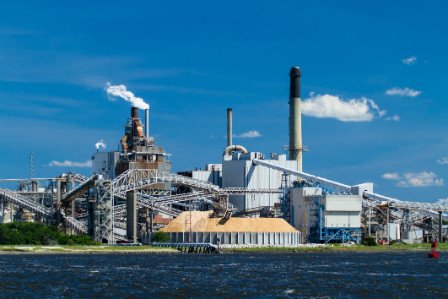Pulp, Paper and Paperboard Effluent Guidelines

The EPA promulgated initial Effluent Guidelines and Standards for the Pulp, Paper and Paperboard category (40 CFR Part 430) in 1974 and 1977, amended the regulations in 1982 and 1986, and promulgated a major amendment covering toxic pollutants in 1998. The Effluent Guidelines are incorporated into NPDES permits for direct dischargersA point source that discharges pollutants to waters of the United States, such as streams, lakes, or oceans., and permits or other control mechanisms for indirect dischargersA facility that discharges pollutants to a publicly owned treatment works (municipal sewage treatment plant). (see Pretreatment Program).
Pollutants and Subcategories
Regulated Pollutants
The regulated pollutants vary by subcategory, and include:
- biochemical oxygen demand
- suspended solids
- pH (abnormally high or low)
- 2,4,6-trichlorophenol
- 2,3,7,8-tetrachlorodibenzo-p-dioxin (TCDD)
- pentachlorophenol
- zinc
- adsorbable organic halides (AOX)
- chemical oxygen demand
- chloroform
- trichlorosyringol
- 2,4,5-trichlorophenol
- 3,4,5-trichlorocatechol
- 3,4,5-trichloroguaiacol
- 3,4,6-trichlorocatechol
- 3,4,6-trichloroguaiacol
- 4,5,6-trichloroguaiacol
- tetrachlorocatechol
- tetrachlorguaiacol
- 2,3,4,6-tetrachlorophenol
- 2,3,7,8-tetrachlorodibenzofuran (TCDF)
Facilities Covered
| Subpart | Processes Included |
|---|---|
| A. Dissolving Kraft | Dissolving pulp at kraft mills |
| B. Bleached Papergrade Kraft and Soda | Market pulp at bleached kraft mills; paperboard, coarse paper, and tissue paper at bleached kraft mills; pulp and fine papers at bleached kraft mills; and pulp and paper at soda mills |
| C. Unbleached Kraft | Pulp and paper at unbleached kraft mills including linerboard or bag paper and other mixed products; pulp and paper using the unbleached kraft-neutral sulfite semi-chemical (cross recovery) process; and pulp and paper at combined unbleached kraft and semi-chemical mills, wherein the spent semi-chemical cooking liquor is burned within the unbleached kraft chemical recovery system |
| D. Dissolving Sulfite | Pulp at dissolving sulfite mills for the following grades: nitration, viscose, cellophane, and acetate |
| E. Papergrade Sulfite | Calcium, magnesium, or sodium-based pulps; ammonium-based pulps; specialty grade pulps. Pulp and paper at papergrade sulfite mills where blow pit pulp washing techniques are used and pulp and paper at papergrade sulfite mills where vacuum or pressure drums are used to wash pulp |
| F. Semi-Chemical | Pulp and paper at semi-chemical mills using an ammonia base or a sodium base |
| G. Mechanical Pulp | Pulp and paper at groundwood chemi-mechanical mills; pulp and paper at groundwood mills through the application of the thermo-mechanical process; pulp and coarse paper, molded pulp products, and newsprint at groundwood mills; and pulp and fine paper at groundwood mills |
| H. Non-Wood Chemical Pulp | Pulp and paper at non-wood chemical pulp mills |
| I. Secondary Fiber Deink | Pulp and paper at deink mills including fine papers, tissue papers, or newsprint |
| J. Secondary Fiber Non-Deink | Paperboard from wastepaper from noncorrugating medium furnish or from corrugating medium furnish; tissue paper from wastepaper without deinking at secondary fiber mills; molded products from wastepaper without deinking; and builders' paper and roofing felt from wastepaper |
| K. Fine and Lightweight Papers from Purchased Pulp | Fine papers at nonintegrated mills using wood fiber furnish or cotton fiber furnish; and lightweight papers at nonintegrated mills or lightweight electrical papers at nonintegrated mills |
| L. Tissue, Filter, Non‑woven, and Paperboard from Purchased Pulp | Tissue papers at nonintegrated mills; filter and non-woven papers at nonintegrated mills; and paperboard at nonintegrated mills |
Best Management Practices
-
control of leaks and spills
-
control intentional diversions of spent pulping liquor, soap, and turpentine
Guidance Document
- Permit Guidance Document (2000)
Guidance for NPDES permit authorities and POTWs in implementing the 1998 amendments to Subparts B and E
Rulemaking History
2007 Amendment
- Final rule (March 12, 2007)
2002 Amendment
- Final rule (September 19, 2002)
1999 Amendment
- Final rule (July 7, 1999)
1998 Amendments
Minor Corrections
- Final rule (August 7, 1998)
Cluster Rule
- Final rule (April 15, 1998)
- Development Document (1997)
Industry description, wastewater characterization, treatment technologies, regulatory compliance cost estimates and pollutant loadings for the final rule - Technical Support Document for Best Management Practices (1997)
BMPs for bleached papergrade kraft and soda, and papergrade sulfite mills. The BMPs establish controls that reduce the release of toxic, conventional, and nonconventional pollutants to surface waters. - Economic Analysis
- Development Document (1997)
- Proposed rule (December 17, 1993)
1986 Amendment
- Final rule (December 17, 1986)
1982 Amendment
- Final rule (November 18, 1982)
- Development Document (October 1982)
Industry description, wastewater characterization, treatment technologies, regulatory compliance cost estimates and pollutant loadings for the final rule
1977 Amendment
- Final rule (January 6, 1977)
- Interim final rule (February 19, 1976)
1974 Initial Rulemaking
- Pulp, Paper & Paperboard Category
- Final rule (May 29, 1974)
- Builders Paper Category
- Final rule (May 9, 1974)
Additional Information
For additional information regarding Pulp, Paper and Paperboard Effluent Guidelines, please contact Ahmar Siddiqui (siddiqui.ahmar@epa.gov) or 202-566-1044.
